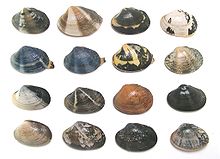Ruditapes philippinarum
| Ruditapes philippinarum | |
|---|---|
 | |
| Scientific classification | |
| Domain: | Eukaryota |
| Kingdom: | Animalia |
| Phylum: | Mollusca |
| Class: | Bivalvia |
| Order: | Venerida |
| Superfamily: | Veneroidea |
| Family: | Veneridae |
| Genus: | Ruditapes |
| Species: | R. philippinarum |
| Binomial name | |
| Ruditapes philippinarum (A. Adams & Reeve, 1850) | |
| Synonyms | |
| |
Ruditapes philippinarum, the Manila clam,[1] is an edible species of saltwater clam in the family Veneridae, the Venus clams.[2][3]Common names include Manila clam, Japanese littleneck clam, Japanese cockle, and Japanese carpet shell.[4] In Japan, it is known as asari. In Korea, it is known as bajirak.[5][6]
The clam is commercially harvested, and is the second most important bivalve grown in aquaculture worldwide.[7]
Description


The shell of Ruditapes philippinarum is elongate, oval, and sculptured with radiating ribs.[8] It is generally 40 to 57 millimeters wide, with a maximum width of 79 millimeters.[9]
Distribution
This clam is native to the coasts of the Indian, Philippines and Pacific Oceans from Pakistan and India north to China, Japan, Korea and the Kuril Islands.[10] It has an extensive nonnative distribution, having been introduced accidentally and purposely as a commercially harvested edible clam. It is now permanently established in coastal ecosystems in many parts of the world.[11]
Habitat

This burrowing clam is most abundant in subtropical and cooler temperate areas. It can be found in shallow waters in substrates of coarse sand, mud, and gravel.[9] It lives in the littoral and sublittoral zones.[12] It burrows no more than about 10 centimetres into the substrate. It sometimes lives in eelgrass beds.[12]
This species lives in many types of habitat, being found in the intertidal zone, brackish waters,[12] estuaries, and under ice. It survives in a range of salinities and temperatures, with narrower ranges required for breeding.[9]
Biology and ecology
This clam may become sexually mature in its first year of life, when it reaches about 15 millimeters in width, especially in warmer areas such as Hawaii. In cooler areas it begins breeding at older ages and larger sizes. In warmer regions it spawns year-round, but only in the summer in cooler areas. The fecundity of the species increases with size, a 40-millimeter female producing up to 2.4 million eggs.[9]
Commercial value
Manila clam represents 25% of commercially produced mollusks in the world.[7] The species is considered to be a sustainable aquaculture product.[13] It is sold live or frozen.[13]
Culinary uses
The clam is frequently eaten in Asia, especially in the Philippines, Korea, and Japan, where they are often used in soups and noodle dishes.
-
 Japanese miso soup with asari clams
Japanese miso soup with asari clams -
 Japanese udon noodles with asari clams
Japanese udon noodles with asari clams -
 Japanese ramen noodles with asari clams
Japanese ramen noodles with asari clams -
 Japanese senbei cookies with dried asari clam
Japanese senbei cookies with dried asari clam -
 Korean kal-guksu noodles with bajirak clams
Korean kal-guksu noodles with bajirak clams -
 Korean kongnamul-guk (soybean sprout soup) with bajirak clams
Korean kongnamul-guk (soybean sprout soup) with bajirak clams
References
- ^ Cordero, David; Delgado, Marina; Liu, Baozhong; Ruesink, Jennifer; Saavedra, Carlos (3 January 2017). "Population genetics of the Manila clam (Ruditapes philippinarum) introduced in North America and Europe". Scientific Reports. p. 39745. doi:10.1038/srep39745.
- ^ "Ruditapes philippinarum". MolluscaBase. Retrieved 27 April 2024.
- ^ "Ruditapes philippinarum". Catalogue of Life. Retrieved 27 April 2024.
- ^ Cohen, A.N. 2011. Venerupis philippinarum. The Exotics Guide: Non-native Marine Species of the North American Pacific Coast. Center for Research on Aquatic Bioinvasions, Richmond, California, and San Francisco Estuary Institute, Oakland, California. Revised September 2011.
- ^ "'Bajirak, bajirak!': Fresh sound alerting the arrival of spring".
- ^ "바지락". nibr.co.kr.
- ^ a b Cordero, D., et al. Population genetics of the Manila clam (Ruditapes philippinarum) introduced in North America and Europe. Scientific Reports 7, Article number: 39745. 3 January 2017.
- ^ Morris, R.H., Abbott, D.P., & Haderlie, E.C. (1980). Intertidal Invertebrates of California. Stanford, CA: Stanford University Press.
- ^ a b c d Fofonoff P. W., et al. National Exotic Marine and Estuarine Species Information System (NEMESIS): For Ruditapes philippinarum. Accessed 29 April 2024.
- ^ Fisheries and Aquaculture Organization of the United Nations: For Ruditapes philippinarum. Accessed 29 April 2024.
- ^ "Ruditapes philippinarum". iNaturalist. Retrieved 27 April 2024.
- ^ a b c Palomares, M.L.D. and D. Pauly (Eds.) SeaLifeBase, Version 03/2024: For Ruditapes philippinarum. Accessed Accessed 29 April 2024.
- ^ a b Manila Clam. FishChoice.com
Further reading
- Milan, M. et al. 2011. Transcriptome sequencing and microarray development for the Manila clam, Ruditapes philippinarum: Genomic tools for environmental monitoring. BMC Genomics 12:234.
- Talley, D. M., Talley, T. S., & Blanco, A. 2015. Insights into the Establishment of the Manila Clam on a Tidal Flat at the Southern End of an Introduced Range in Southern California, USA. PLoS One 10(3): e0118891.
- v
- t
- e
| Clams | |
|---|---|
| Cockles | |
| Mussels |
|
| Oysters |
|
| Scallops |
| Abalone | |||||||
|---|---|---|---|---|---|---|---|
| Conches | |||||||
| Limpets | |||||||
| Periwinkles | |||||||
| Whelks | |||||||
| Other snails |
|
| Cuttlefish | |
|---|---|
| Octopus | |
| Squid |
External links
 Media related to Ruditapes philippinarum at Wikimedia Commons
Media related to Ruditapes philippinarum at Wikimedia Commons Data related to Ruditapes philippinarum at Wikispecies
Data related to Ruditapes philippinarum at Wikispecies




















